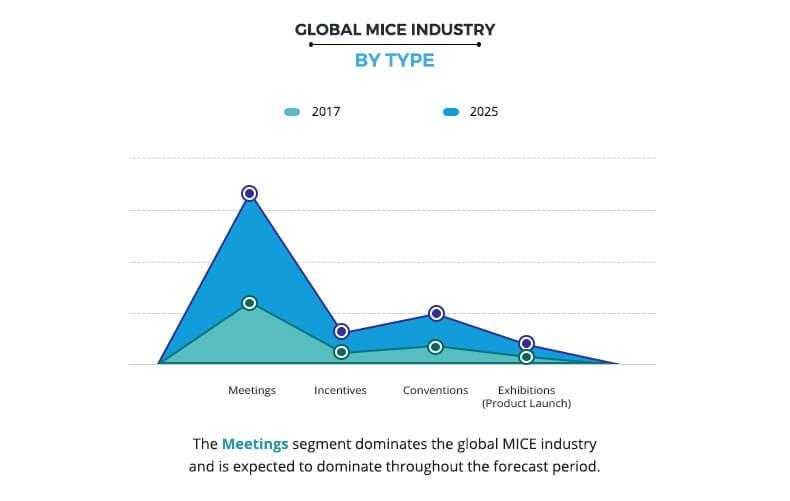The global MICE industry is projected to reach $1,439.3 Billion, in 2025
According to a new report published by Allied Market Research, the global MICE industry size was $805 billion in 2017 and is projected to reach $1,439.3 billion in 2025, registering a growth of 7.6% from 2018 to 2025. The term MICE in the context of travel is an acronym for meetings, incentives, conferences, and exhibitions.
The term MICE is more commonly known as the Meetings Industry, grew out of the travel industry, which evolved to coordinate the hosting, management, and promotion of tourism businesses with strategic initiatives and could be for a professional trade organization, a training topic, or a regional interest.
Under the guise of business tourism, MICE is a fast-growing segment of the wider tourism industry, is considered as one of the biggest revenue generators in the travel industry – that can generate significant income for urban areas in countries around the world. However, in order to remain a top MICE destination, Western Cape Province, and South Africa, in general, need to continue to invest, develop, and be promoted for having international standards, accommodation, quality of infrastructure, accessibility, and venues, as more and more destinations continue to
invest in the sector.
Travelers attending MICE events are more and more mixing business with leisure tourism, whilst they are actually business travelers, who come to connect to different sectors of the tourism and hospitality industry and is signified as “Bleisure”. As MICE crosses borders (regional and continental) and industries (from medical to engineering), it is a rapidly evolving and pivoting industry. Maintaining competitiveness, profitability, and attractiveness is a complex exercise that is critically dependent on understanding what is happening in the industry at a macro and micro level. The industry also expands into other periphery creative services that include show displays, directional signages, banners, kiosks/exhibit space, event photography, and AV/technical production; and event marketing and sponsorship management, group air fulfillment, on-site event logistics, and staffing, supplier management, virtual meetings, and risk management services.
According to Allied Market Research, In 2017, the meeting segment has attributed the highest share of the overall MICE industry – primarily due to a significant global rise in the number of (SME) Small and Medium-Sized enterprises specifically, in the emerging economies. Moreover, an unprecedented surge in travel and tourism, as well as the hospitality sector, has further added to the growth of this segment.
Meanwhile, the incentive segment a management tool for rewarding and motivating sales representatives, dealers, distributors, production workers, support staff, and in some cases, customers are estimated to be the fastest-growing segment in the event type segment during the forecast period.

MICE and Tourism Value Chain
The MICE and Tourism value chain (Figure 2) defines the flow of value from buyers to service providers. The MICE industry truly consists of all parties involved in distribution and service provision. The development of the MICE industry would involve strategically bringing all these players into alignment with a central vision and goal. These players include:
Online travel portals
Travel agents
MICE operators
Destination management companies
Transportation providers (air, sea, land)
Accommodation and lodging providers
Hospitality providers
Excursion planners

Supporting this is the data stating that there is an expected increase in average global hotel rates and airfare (3.7% and 2.6%, respectively), ultimately driven by a 5-10% forecasted growth in MICE demand (see Figure 3). Increasing accessibility and economic strength are leading to a surge in small and medium-sized meetings/events, with meetings hosting 101 – 500 attendees seeing a rise in demand.
Strategic Insight – Key Travel Industry Megatrends
The world is transforming. The scale, scope, and complexity of change are unlike anything humanity has experienced before, shaking the foundations that society has accepted as the norm. These converging forces – or megatrends – present immense opportunities for those who recognize them and adapt their strategies.
MICE, Travel, and Tourism is one of the fastest-growing sectors, accounting for more than 10% of global GDP in 2017. Sustaining its growth and hitting industry forecasts, such as 1.8 billion international arrivals by 2030, will require continuous innovation and reinvention across the sector. Leaders will need to foster a nimble outlook that can respond to new customer demands and expectations, the next revolution in data capabilities, and heightened business risks.
Through global research and investigative initiative, the World Travel & Tourism Council has earmarked five transformative, interlinked travel megatrends that will shape the industry, and have an impact on the dependent MICE industry. (World Tourism and Travel Council, 2019)
- The reality, Enhanced: Hyper-connectivity, access to information, and personalization have led to an experience-driven world fuelled by personal enrichment, self-direction, and community
- Life, Restructured: Fluidity, autonomy, and social engagement are driving the gig & sharing economy which in turn are redefining relationships, disrupting industries, and creating new expectations for work and life
- Data, Revolutionised: Data, through IoT and machine learning, has become a driving force of the economy, enabling unprecedented personalization and connectivity
- Power, Redistributed: Power and demographic shifts from West to East, and nations to cities are redefining centers of influence and reshaping global markets, while individuals are becoming increasingly more mobile and
demanding more accountability - Consumption, Reimagined: As a response to escalating environmental risks, consumer awareness has translated into more ethical and resource-efficient lifestyles which are driving the decision-making of younger generations
Download Full Report here










0 Comments